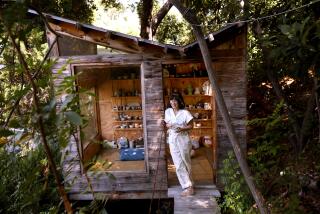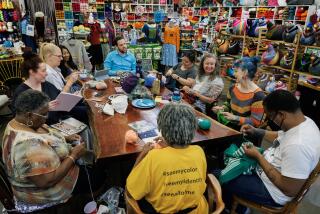England: Arts and Crafts in the Cotswolds
Reporting from Cheltenham, England — I was recently invited to review a superb jazz festival in Cheltenham, about two hours west of London, in the Cotswolds.
“You’re going to the Cotswolds?” my friends gushed.
“Yes,” I said. “ Hugh Masekela will be there. And Jack DeJohnette. Nigel Kennedy. Madeleine Peyroux. Nice lineup.”
FOR THE RECORD:
English artisans: An article in the July 25 Travel section about the arts scene in England’s Cotswolds region said that Lechlade was southwest of Cheltenham. Actually, Lechlade is southeast of Cheltenham. —
“Yes, but the Cotswolds!” they said, without the slightest interest in the jazz festival. “Be sure to go to Chipping Campden. And the Slaughters. Bourton-on-the-Water. Stow-on-the-Wold.”
Chipping who? Stow-on-the-what?
OK, I admit it. I’ve never been a fan of “Merry Olde England,” preferring what’s happening now to canned antiques from the past. But after the Cheltenham Jazz Festival, I found something that was both contemporary — and antique — that will surely lure me back to the Cotswolds: a living tradition of arts and crafts.
William Morris, one of my heroes from my ‘60s college days and the founder of the English Arts and Crafts movement, set up shop in the Cotswolds in 1871. Morris, a poet, designer and visionary socialist, believed that the Industrial Revolution, while making goods available, had cheapened daily life. Utilitarian things such as bedspreads, curtains, cups and saucers, he argued, should also be beautiful. And handmade.
It was a utopian vision, of course, and one that could have come only from an upper-class bloke with time on his hands. But the idea has endured. Whenever you see a stoneware mug, a hand-knit cap or a tulip-and-tendril-embroidered curtain, you’re looking at Morris’ legacy. Today, thanks to him, a thriving community of high-quality potters, silversmiths, cabinetmakers, weavers, furniture designers, cheese crafters and other cottage manufacturers flourishes in the Cotswolds. Dropping in on these artists as part of a tour of the more well-known sights is a great way to get a personal feel for the region and find some lovely gifts, as well.
Note: To call these numbers from the U.S., dial 011-44 before the local number.
There are dozens of Arts and Crafts destinations, but a good place to start is the homey, rambling collection at the Cheltenham Art Gallery & Museum (Clarence Street, Cheltenham; 1242-237-431, https://www.cheltenham.artgallery.museum). Here you can familiarize yourself with the major players of the A&C movement and feast your eyes on an 1856 round pine table made by Morris himself; a luminous green fish plate by potter Michael Cardew; and a dazzling inlaid piano designed by C.R. Ashbee.
Cheltenham is a good home base for touring the Cotswolds. It’s a sweet little city, with smart shops and rows of stately Regency architecture that went up in the early 19th century to house a leisure class that spent the social season here. Today, Cheltenham focuses on leisure of a cultural stripe, hosting four world-class festivals: literature (Oct. 8-17), jazz (April 27-May 2), science and (classical) music (2011 dates to be announced) (0844-576-8970, if calling from the U.S., drop the first 0, https://www.cheltenhamfestivals.com).
From Cheltenham, it’s about 26 miles southwest to Lechlade, where Morris discovered Kelmscott on the upper reaches of the River Thames (1367-252-486, https://www.kelmscottmanor.org.uk). This three-story, 17th century stone manor house, with its steeply pitched peaks and banks of tall, leaded glass windows, is a glorious retreat. Surrounded by lush lawns, a craggy, twisted ash, flowering fruit trees and gardens festooned with pansies and bluebells, the house shares its serene grounds with an old stone barn and several outbuildings that now offer an excellent gift shop and restaurant.
Morris lived at Kelmscott with his wife, Jane, his two daughters, Jenny and May, and his business partner, the great poet and pre-Raphaelite painter Dante Gabriel Rossetti. These were Bohemian days. When Morris discovered his wife and Rossetti were having an affair, Morris went to Iceland to let it blow over. The affair ended, but Morris and Rossetti nevertheless fell out and the painter later attempted suicide.
Each room at Kelmscott is like a miniature museum, stuffed with handmade decorated art and craftwork. Highlights include Turkish-blue fireplace tiles by Edward Burne-Jones; an 1896 facsimile of the illuminated edition of Chaucer’s “ Canterbury Tales”; Sussex chairs, made of ebonized wood and cane; Morris’ bed, with its canopy and tendril embroidery by Jane and May; and Rossetti’s famous painting of the raven-haired, ruby-lipped Jane, sitting at her desk in a luminous blue silk dress.
Morris continued to visit Kelmscott until his death in 1896, but other artists soon discovered the Cotswolds’ rural charms. In 1926, renowned English potter Michael Cardew started Winchcombe Pottery, where he threw pots in the tradition of 17th century English slipware (Broadway Road, Winchcombe; 1242-602-462, https://www.winchcombepottery.co.uk). Ray Finch took over Winchcombe in 1939. When I arrived one sunny spring morning, Ray and his son Mike, who now runs the show, were sitting outdoors with two other potters, deeply ensconced in tea and crossword puzzles. After savoring a few last sips, Mike joined me at the rear of the property.
“This was the original kiln,” he explained, pointing to a pile of rubble. Behind us stood an exotic, 20-foot tall red brick “bottle kiln,” so named for its shape, with vines creeping over it.
“Cardew built this one,” he said. “They used coal in those days. Now we use wood and oil. But look, there’s a book about all this. When you’re done looking ‘round, pop up to the shop and I’ll see if I can’t find one for you.”
Wishing I had more luggage space, I chose a small, narrow-necked blue bottle from the dazzling display table and bought Ron Wheeler’s handsome book “Winchcombe Pottery: The Cardew-Finch Tradition” for my wife, who is a potter. (It turned out to be a real find. When I got home, I discovered the book was out of print.)
It was getting time for lunch, so I headed for the Daylesford Organic Farmshop, near Kingham, the Cotswolds’ answer to Napa Valley ([1608] 731-700, https://www.daylesfordorganic.com). Lady Carole Bamford, wife of industrial magnate Anthony Bamford, founded this sunny complex, with sparkling white trim, which features a high-end delicatessen and food store, creamery, bakery, a small café, garden shop, organic garden, cheese factory, wine and chocolate shops and even a clothing store. Patronized by such illustrious locals as Prince Charles and Camilla and Kate Winslet, it is decidedly upmarket and worth every penny. Among its delicacies are haddock and leek pie, herb vinegars, powder blue duck eggs, fresh asparagus, homemade ketchup and Daylesford elderflower ice cream made with Jersey cream.
The real finds are the boutique cheeses, including Daylesford’s own organic Cheddar (delicious) and Little Wallop, a goat’s cheese washed in cider brandy (tangy) made by Cotswolds resident Alex James of the British supergroup Blur. Noshing outside at a picnic table on local cheese, organic apples, char-grilled artichokes and slices of ham was just the ticket. If you want a sit-down lunch at the café, be sure to call ahead.
Cotswold wool merchants sold their fleeces in Chipping Campden, northeast of Cheltenham. Centuries later, in 1902, Arts and Crafts designer Ashbee, following Morris, moved his East London Guild of Handicraft to this medieval market town. The careers and artifacts of Ashbee and other A&C luminaries are documented with a fine visual flourish at Chipping Campden’s excellent 3-year-old Court Barn Museum (Church Street, Chipping Campden; 1386-841-951, https://www.courtbarn.org.uk). Here you can see work by bookbinder Katharine Adams, engraver F.L. Griggs, illustrator and glass artist Paul Woodroffe, industrial designer Robert Welch, potters Finch and Cardew, and furniture designer Gordon Russell.
Ashbee set up his workshop in an old silk mill on Chipping Campden’s Sheep Street. Although the guild went belly up after only five years, one of its silversmiths, George Hart, hung on. More than 100 years later, Hart’s grandson David and David’s son William and nephew Julian can still be found working at Hart Gold & Silversmiths in the Old Silk Mill (Sheep Street, Chipping Campden; 1386-841-100, https://www.hartsilversmiths.co.uk). In its cluttered office hangs a large, framed black-and-white photo of George Hart taken by Frank Lloyd Wright, who visited in 1912, and one of Hart’s ornate repoussé (beaten copper) works depicting vines, birds and a vase.
A Bunsen burner glowed and antique tools hung on the wall, and I found it easy to imagine the Old Silk Mill more than 100 years ago. That sense of continuity and tradition is palpable on the Cotswolds Arts and Crafts trail. Maybe, I thought, there really was something to this Merry Olde England business.
More to Read
Sign up for The Wild
We’ll help you find the best places to hike, bike and run, as well as the perfect silent spots for meditation and yoga.
You may occasionally receive promotional content from the Los Angeles Times.






